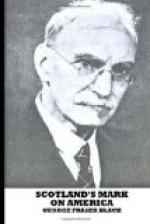McClellan (1823-74), was professor of anatomy in Pennsylvania
Medical College, and his grandson was George McClellan
(1849-1913), the eminent Philadelphia anatomist.
Dr. Peter Middleton (d. 1781), a native of Scotland,
made the first dissection on record in this country
before a class of students and in 1767 established
a Medical School in New York which was subsequently
merged in the King’s (now Columbia) College.
Dr. William Currie (1754-1823), served in the medical
service during the Revolutionary War, and was reputed
one of the most gifted men of his time as physician
and classical scholar. Horatio Gates Jameson
(1778-1855), distinguished physician and surgeon,
was son of Dr. David Jameson who had emigrated to Charleston
in 1740 in company with Dr. (afterwards General) Hugh
Mercer. Granville Sharp Pattison (1791-1851),
anatomist, born near Glasgow, held several professional
appointments in this country and founded the Medical
Department of the University of the City of New York.
Dr. John Kearsley Mitchell (1793-1858), poet, botanist,
and eminent physician of Philadelphia, was son of
Dr. Alexander Mitchell who came from Scotland in 1786.
His son, Dr. Silas Weir Mitchell, born in 1829, was
distinguished for his researches in toxicology, the
nervous system, etc., and as one of the most
distinguished of American authors. One of the
founders of the City Hospital, Albany, and Surgeon-General
of New York State, was Dr. James McNaughton (1796-1874),
born at Kenmore, Aberfeldy. Dr. Daniel McRuer
(1802-73), born in Knapdale, Argyllshire, “a
typical Scotchman with a ‘burr’ in his
talk,” performed great service in the Civil
War as an army Surgeon. Dr. John Watson (1807-1863),
organizer of one of the first dispensaries for the
treatment of skin diseases and introducer of reforms
in the New York Hospital, was an Ulster Scot.
John Murray Carnochan (1817-87), one of the most distinguished
surgeons of his day, was of Scottish parentage.
Ferdinand Campbell Stuart (b. 1815), inventor of various
instruments used in genito-urinary diseases and one
of the founders of the New York Academy of Medicine,
was grandson of Rev. Archibald Campbell of Argyllshire.
Dr. David Hayes Agnew (1818-92) was of Scottish descent.
In his work “he attained a degree of eminence
which has rarely, if ever, been equaled, and to which
our own times and generation furnish no parallel.”
William Thomas Green Morton (1819-68), the discoverer
of anaesthesia, was also of Scottish origin.
Dr. Robert Alexander Kinloch (1826-91), of Scottish
parentage, was the first American surgeon to resect
the knee joint for chronic cases, also the first to
treat fractures of the lower jaw and other bones by
wiring the fragments, and was also the first in any
country to perform a laparotomy for gunshot wounds
in the abdomen without protrusion of the viscera.
Dr. George Troup Maxwell (1827-1879), was inventor
of the laryngoscope. James Ridley Taylor (1821-1895),
who entered the medical profession after middle life,




